21 February 2025
Global Market Outlook
Global Market Outlook
Looking to buy the dips
US President Donald Trump has hit the ground running, but equities have overcome initial tariff fears. While the inflation debate remains unresolved, the case to prefer equities over bonds amid a strong US growth environment remains unchanged.
We do not expect the recent outperformance of Euro area and China equities over US equities to be sustainable. As such, we retain a preference for US equities globally and Indian equities within Asia ex-Japan and would use recent underperformance to rotate into our preferred regions.
Gold likely faces a temporary pullback amid stretched positioning, but we would buy any dip towards USD 2,800/oz. Bond yields and the USD are likely to remain rangebound.
Are Trump’s tariffs a headwind or just noise?
What are the near-term macro factors to watch?
Are quant models still bullish on equities?
Strategy
Investment strategy and key themes
|
|
||||
|

12m Foundation Overweights:
- Equities, Gold
- US equities, DM HY bonds
Opportunistic ideas – Equities
- US software, communications, major & regional banks, small caps
- China non-financial high divi SOEs & Hang Seng Tech Index
- India large cap equities
Opportunistic ideas – Bonds
- Global convertible bonds
- US Agency MBS
- Euro govt. bonds (FX-hedged)
- Asian High Yield USD bonds
Looking to buy the dips
- US President Trump has hit the ground running, but equities have overcome initial tariff fears. While the inflation debate remains unresolved, the case to prefer equities over bonds amid a strong US growth environment remains unchanged.
- We do not expect the recent outperformance of Euro area and China equities over US equities to be sustainable. As such, we retain a preference for US equities globally and Indian equities within Asia ex-Japan and would use recent underperformance to rotate into our preferred regions.
- Gold likely faces a temporary pullback amid stretched positioning, but we would buy any dip towards USD 2,800/oz. Bond yields and the USD are likely to remain rangebound.
A strong start for equity markets
Global equity markets have kicked off the year with strong returns. Global stocks and gold have handily outperformed bonds and cash, despite concerns about US President Trump’s policies ahead of his inauguration. However, Euro area equities have performed surprisingly well, despite concerns about economic and earnings growth.
Trump hits the ground running
From a financial market perspective, Trump’s initial weeks as US President have been less disruptive than originally feared. Equity markets have continued to climb despite his tariff announcements and bond yields have remained relatively restrained. Debate on the risk of inflation from Trump’s policies continues – his tariff plan is arguably inflationary and US inflation edged higher in the latest data release. We still see room for the Fed to cut rates further, but we dial back our expectations slightly to two 25bps rate cuts in 2025 (vs. three expected earlier).
In the bigger picture, we remain comfortable with our preference for stocks over bonds and cash, with our long-term quantitative models pointing to further gains in equities. While investor positioning is admittedly quite bullish, we believe a catalyst for a significant pullback remains absent – a view supported by the still-positive signal from our short-term equity market models.
Fig. 1 Europe and China equities have outperformed this year, but we believe US outperformance will resume
US vs. Europe equity indices; relative economic surprises
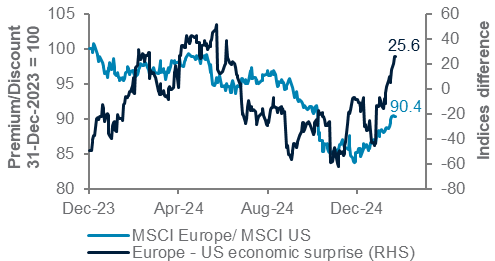
Source: Bloomberg, Standard Chartered
Europe, China equity rally sustainable?
One key question raised by year-to-date performance is whether the outperformance of Euro area equities (over their US peers) is sustainable. We are not convinced. The recent outperformance has arguably been a partial reversal of extreme bearish sentiment. Optimism over a potential end of the Ukraine war and expectations that the upcoming German elections will lead to a significant revival in fiscal spending have also helped.
In our view, sustained outperformance of Euro area equities would likely require both a strong catalyst (such as a credible plan to significantly expand Euro area fiscal spending) and a sustainably weaker USD. For the time being, at least, these two drivers do not appear to be in place. As such, we would buy the (relative) dip in US equities.
A second question is whether the strong gains in China equities can extend further. Here, we are similarly circumspect. Market optimism has been sparked by the emergence of China’s low-cost AI model, DeepSeek, and signals that its policymakers are tilting towards reviving growth. However, US tariffs remain a threat, significant fiscal stimulus has not been forthcoming and bond yields suggest deflationary pressures have not yet abated. We would continue to add to our focused opportunistic ideas in China.
A third question is whether the pullback in Indian equities is temporary. Slower growth and earnings data, foreign investor selling and concerns over the impact of US tariffs have led Indian equities into correction (>10% pullback) territory. However, 10%+ corrections are not uncommon within structural equity bull markets and valuations have now eased closer to their 10-year average. Consensus estimates suggest earnings growth is likely to improve from here, particularly given recent policy stimulus. Therefore, we would view the current pullback as an opportunity to add exposure.
Overall, we believe the case for a relative preference for US equities (among major regions) and Indian equities (within Asia ex-Japan) remains intact. For both markets, recent dips have likely created an opportunity to add exposure.
Fig. 2 The USD is expensive by some measures but is likely to consolidate within a tight range in the near term
USD index (DXY)

Source: Bloomberg, Standard Chartered
Softer bond yields and a rangebound USD
The US dollar has largely mirrored the moderation in US bond yields, pulling back from recent range-highs. We expect both US yields and the USD to largely trade in a range from here, led by an unresolved inflation debate. US tariff policies, immigration curbs and growth data are likely to keep inflation concerns alive, but contained wage growth and cooling shelter inflation are likely to keep overall inflation data in check. However, we do believe this modestly weakens the case for Fed rate cuts. Thus, we expect two Fed rate cuts this year.
Within bonds, the inflation debate and a still-stable growth outlook mean we continue to see an attractive risk/reward in DM HY bonds. While credit spread valuations are not cheap, still-strong growth and high credit quality are likely to keep spreads narrow, allowing investors to earn the higher yield.
Gold due for a (brief) breather
The relentless rise in gold prices has meant that the safe haven asset has achieved our 12-month price target in less than three months. Data suggests gains have been led by strong central bank purchases and concerns about inflation.
We remain positive on gold over 6-12 months as we believe central bank reserve diversification strategy has further to run. Any short-lived equity market volatility and demand for inflation-protecting real assets are likely to be additionally supportive factors. Rapid gains in recent weeks, coupled with stretched investor positions, suggest a brief pullback towards USD 2800/oz is increasingly likely. However, we believe the drivers for the gold price rally remain unchanged. Therefore, we would view any such pullback as an opportunity to add exposure.
Adjusting our opportunistic ideas
We maintain our existing bond opportunistic ideas this month. In equities, though, we close our US technology sector idea after strong gains. In its place, we open a US software sector idea. This, we believe, will allow continued exposure to the US technology sector and the AI rally, but in a way more focused on the likely future gainers from the AI wave.
Foundation asset allocation models
The Foundation and Foundation+ models are allocations that you can use as the starting point for building a diversified investment portfolio. The Foundation model showcases a set of allocations focusing on traditional asset classes that are accessible to most investors, while the Foundation+ model includes allocations to private assets that may be accessible to investors in some jurisdictions, but not others.
Fig. 3 Foundation asset allocation for a balanced risk profile

Fig. 4 Foundation+ asset allocation for a balanced risk profile
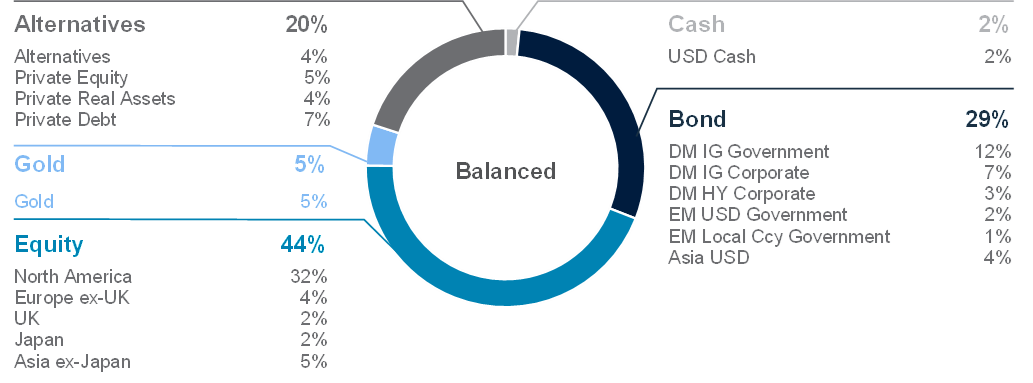
Fig. 5 Multi-asset income allocation for a moderate risk profile

Source: Standard Chartered
Foundation: Our tactical asset allocation views
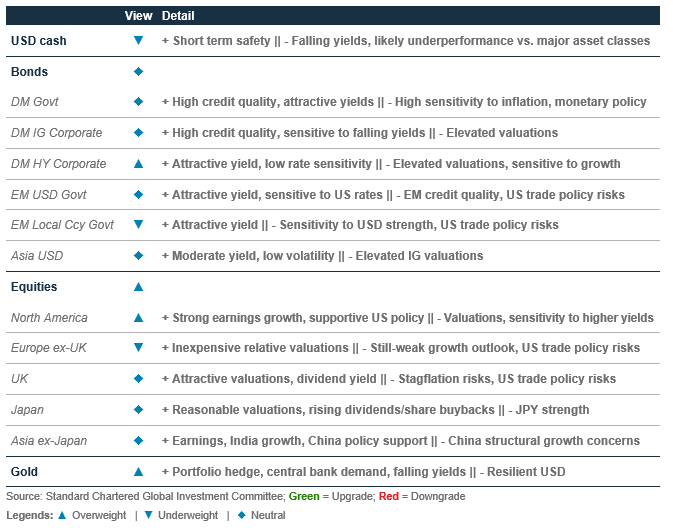
Fig. 6 Performance of our Foundation Allocations*
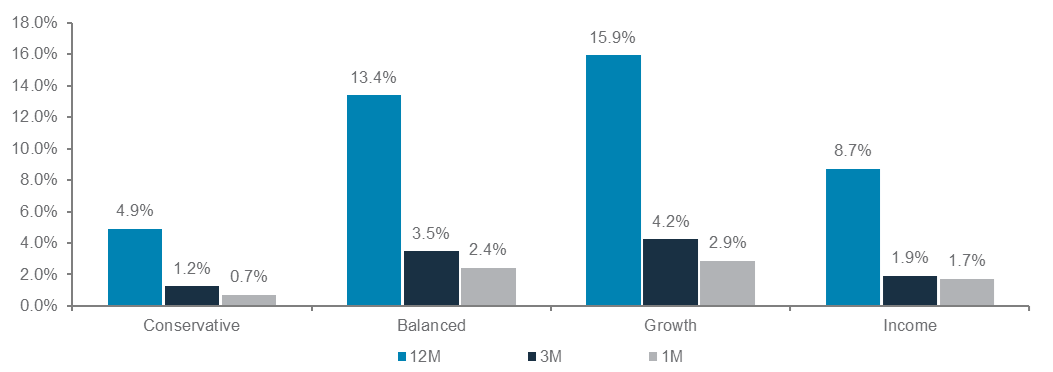
Source: Bloomberg, Standard Chartered; *12-month performance data from 20 February 2024 to 20 February 2025, 3-month performance from 20 November 2024 to 20 February 2025, 1-month performance from 20 January 2025 to 20 February 2025.
Perspectives on key client questions
|
|
||||
Trump’s tariff gambit: Market headwind or just noise?
Since his inauguration, President Trump has reignited trade tensions with a list of new tariff measures. He has imposed tariffs on a wide range of imports into the US, including steel and aluminium, and also introduced the concept of ‘reciprocal tariffs,’ which aims to match the tariffs imposed by other countries on US goods. While Trump’s tariff playbook is hardly new, its impact on financial markets and the economy is far more nuanced than the splash it generates in news headlines. To better understand the implications of Trump’s latest tariffs, we examine four factors to determine whether Trump’s tariff measures are significant or simply noise.
Larger tariffs, larger impact
Tariffs can impact the economy in several ways. At the micro level, they increase costs for businesses that rely on imported goods, potentially leading to higher prices for consumers. At the macro level, they can disrupt global trade, hurt business confidence and slow economic growth. However, the extent of damage depends on several factors: how broad the tariffs are, how long they last, and how businesses and policymakers react. A short-lived tariff skirmish may generate noise but have limited economic impact. In contrast, a full-scale trade war, with retaliatory tariffs by trading partners could potentially tilt the economy towards a recession.
Will tariffs push the US into a recession?
For investors, major stock market downtowns have historically stemmed from economic contractions, not political manoeuvres. Since 1928, nine out of ten S&P500 declines of over 15% in a year were linked to recessions or wars, while the 2022 drop followed aggressive Fed tightening. The sharp sell-off in Q1 18, fuelled by fears of a Fed policy mistake and escalating trade tariffs, underscores how economic uncertainty can unsettle markets even without a recession. While a prolonged trade war could, in theory, affect growth enough to push the US into a recession, the data so far suggests a robust starting point if trade tensions escalate. The Atlanta Fed GDPNow projects steady US Q1 GDP growth of 2.3%, while unemployment at 4.1% in December remained below the Fed’s long-term rate. Historically, energy shocks have also been a key cause of recessions after WW2. A doubling of oil prices in a year has often preceded recessions.

Fig. 7 Many countries charge higher tariff rates on imported goods than the US
Average tariff rates of US and its top trading partners
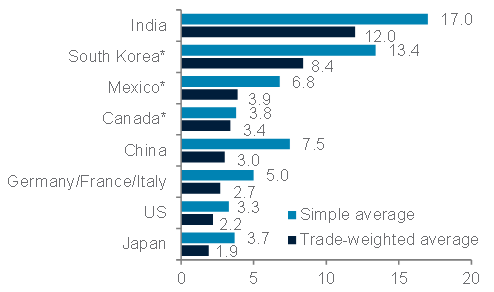
Fig. 8 Feedback loop – tariffs to inflation and growth
How tariffs impact growth and inflation
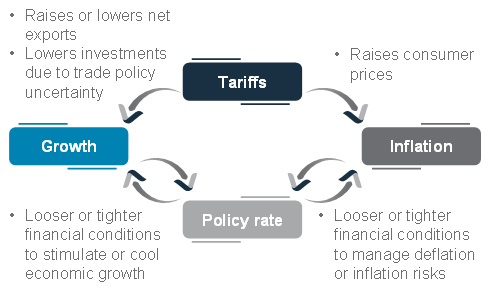
Source: WTO, Standard Chartered *US has free trade agreements with Canada, Mexico and South Korea
It is highly unlikely that we will see a rapid oil price surge this year, given the potential for an oil supply glut on increased flows from Russia and Iraq against generally muted demand. However, if trade tensions rise further, business confidence and corporate spending could decline, leading to slower growth. That’s the real risk investors should watch out for.
Fig. 9 Major market downturns have been mostly tied to economic contractions
Years when annual calendar loss in S&P500 exceeded 15%
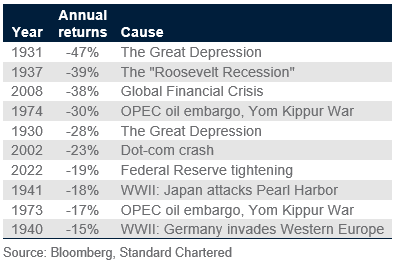
Could a trade war spark a financial crisis?
Financial markets tend to react sharply to uncertainty, but volatility alone does not equate to systematic risk – one having market-wide impact. Financial crises tend to occur when stress in the financial system spills over to the broader economy. The 1997 Asia financial crisis and the 1998 collapse of US hedge fund Long-term Capital Management triggered market sell-offs but did not lead to a US recession. The 2011 European debt crisis rattled global markets but was contained before causing widespread damage. In contrast, the 2008 financial crisis was different – banks were overleveraged, and policymakers were slow to act initially, requiring extraordinary government support to prevent a total collapse.
Today, US banks are in a far stronger position. They are well-capitalised, with solid liquidity buffers and more stringent regulatory oversight. Credit markets remain stable, with no signs of a significant widening in credit spreads.
Fig. 10 Credit markets have remained well-anchored amid tariff noise
Credit spread of DM IG and HY bonds over government debt
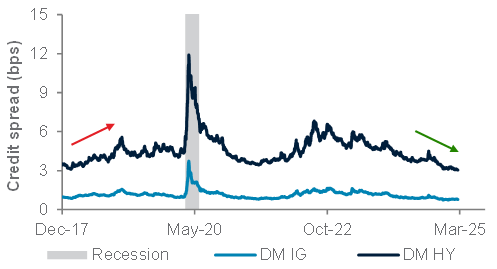
Source: Bloomberg, Standard Chartered
How will policymakers respond?
Policymakers play a crucial role in determining whether an economic shock turns into a full-blown crisis. Their response can either stabilise or exacerbate downturns. The current situation is unique because Trump’s trade policy itself is the cause of uncertainty. While the administration has no incentive to create a recession, trade policy remains unpredictable and markets dislike uncertainty. If economic data begins to deteriorate, investors will look to the Fed to step in, but so far, the Fed has signalled a wait-and-see approach, rather than a willingness to cut rates pre-emptively.
Are investors panicking?
Stock market volatility is often a good indicator of how worried investors truly are. Despite the headlines, markets have been relatively stable amid Trump’s tariff announcements. The volatility index, often referred to as the ‘fear gauge,’ remains below its long-term average. While it briefly rose above 20, its long term average, it quickly settled lower after Trump paused new tariffs on Mexico, as investors looked beyond this short-term uncertainty. Investors are clearly hedging longer-term implications of tariffs – higher inflation – through gold.
What should investors watch next?
Markets are forward-looking; i.e., what happens next is more important than what has already happened. Key to watch will be the potential for escalation – will Trump’s announced tariffs be implemented, and will US trade partners retaliate by the same degree, triggering a tit-for-tat cycle that disrupts global trade flow and economic growth? A second scenario is Trump uses tariffs as temporary tools to extract concessions from trade partners. Additionally, energy prices, corporate earnings, and credit markets are also key. If oil prices were to surge above USD100/bbl, recession risks would increase significantly. Similarly, if companies start cutting earnings estimates due to trade concerns, it would signal a deeper economic slowdown. Finally, if credit spreads begin widening, it could be a red flag that conditions are deteriorating.
What does that mean for asset allocation?
Given our view that tariffs are likely temporary measures intended to extract concessions from trading partners, we remain pro-risk in our asset allocation. While trade tensions may create short-term market fluctuations, the fundamental outlook remains supportive. We continue to favour global equities, with corporate earnings remaining resilient, and a broadening in performance from the US to Europe and China suggests improvements in risk appetite. Within bonds, DM HY bonds continue to offer attractive opportunities amid a strong US labour market and low default rates, while EM bonds have performed surprising well amid tariff-related noise. Lastly, gold remains a key portfolio diversifier, serving as a hedge against geopolitical uncertainty and market volatility. Unless we see signs of trade policies causing deeper economic damage, we believe staying invested in a portfolio of diversified risk assets remains the right approach.
Macro overview – at a glance
Our macroeconomic outlook and key questions
|
Key themes
Fed rate cuts delayed: The US economy remains resilient. An upturn in the manufacturing cycle is helping offset a service sector slowdown. Resilient growth and uncertainty around trade and fiscal policies are likely to keep the Fed from cutting rates, at least at its March meeting. We push back our expectations of the first rate cut this year to Q2, from Q1, and now see the Fed cutting rates by a total 50bps to 4.0% by December. Risks: Tariffs could revive inflation risks, further delaying Fed rate cuts.
ECB to cut further, BoJ to hike: We expect the ECB to cut rates by another 75bps by year end as trade uncertainty dampens growth. A ‘grand coalition’ of centre-right and socialist parties after Germany’s election on 23 February could potentially lead to easier fiscal policy, reviving Euro area’s growth outlook. Unlike other Developed Market central banks, the BoJ is likely to hike rates further this year as strong growth and a tight labour market fuel wages and inflation.
China to ease policy further: China’s National People’s Congress in March is likely to ease fiscal policy to stimulate domestic demand and reduce its reliance on exports amid rising trade uncertainty. A broadening of US tariffs to include Europe and major Emerging Markets is a downside risk, while a trade deal is a likely catalyst for a growth resurgence.
Key chart
Resilient US growth and uncertainty over trade and fiscal policy are likely to delay Fed rate cuts. Except for the BoJ, other major central banks are likely to cut rates more than the Fed amid rising growth risks
Fig. 11 Resilient US growth implies fewer Fed rate cuts than other major central banks
Consensus 2025 GDP growth estimates; money market estimates of rate cuts in next 12 months

Source: Bloomberg, Standard Chartered
Macro factors to watch
Trump’s tariffs and tax cut plan: If Trump’s announced tariffs are implemented, average US import tariffs will rise to the highest level since the 1940s. Based on Fed models used during Trump’s first term, recently announced tariffs are likely to raise US core PCE inflation by 0.7% and hurt US GDP by 1.2% if all tariffs are passed on to consumers and US trade partners retaliate by the same degree. The ultimate impact will depend on actual tariff rates, supply disruptions, the degree of retaliation by trade partners and USD adjustments. However, the announcements so far, and reversals and postponements in certain cases, have raised the odds that Trump is likely to use the tariffs as temporary negotiating tools to win concessions from trade partners. Sustained tariffs are likely to challenge his goal of non-inflationary growth. The risk is that tariffs become sticky if the proceeds are used to fund proposed tax cuts. Thus, Treasury Secretary Bessent’s tax cut plans and Trump advisor Musk’s plans to cut spending are the next focus for investors. We expect the Fed to hold rates for now to assess the economic impact of Trump’s policies.
German election, Ukraine talks: Polls show the German election is likely to lead to a fragmented mandate. In that case, the centre-right parties (CDU/CSU) could form a ‘grand coalition’ with the outgoing socialist party (SPD). Such a coalition would raise the chance of Germany easing its constitutional debt restrictions to boost fiscal spending and implement structural reforms to revive productivity and long-term growth. While trade tensions are likely to rise, a ‘grand coalition’ would be better placed to negotiate trade deals. Trump’s talks with Russian President Putin to end the Ukraine-Russia conflict could potentially lower Europe’s political risk premium. However, trade and political uncertainty is likely to hurt near-term growth, leading the ECB to cut rates.
China’s Congress: China is likely to set a 5% growth target for 2025. To achieve that, it could ease fiscal policy to boost domestic consumption, while the PBoC cuts rates and expands its balance sheet, offsetting the impact of US tariffs, which have doubled to c.20%. Although China has cut its reliance on US exports vs. Trump’s first term, it is more reliant on global exports, making a broader trade war a key risk.
Asset Classes
Bonds – at a glance
|
|
||||
Key themes
We continue to view global bonds as a core holding. Fed rate cuts and contained inflation under our base macro scenario should help cap bond yields. While a sharp move lower in yields appears unlikely, we see current yields offering an opportunity to lock in an attractive income, particularly relative to cash, helping to reduce any reinvestment risk amid falling rates. Any reduction in rate cut expectations and surge in term premiums amid sticky inflation and rising government debt are risks, especially for long duration bonds that are more sensitive to interest rate movements.
Developed Market (DM) Investment Grade (IG) government bonds are a core holding (Neutral). Both nominal and real (inflation-adjusted) yields are attractive from a historical perspective. Our 12-month target for the US 10-year government bond yield is 4.00-4.25%. DM IG corporate bonds are a core holding (Neutral). Tight yield premiums illustrate rich valuations, but we see these supported by solid fundamentals and continued inflows. We are Overweight DM High Yield (HY) corporate bonds. Historical solid performance in soft-or-no-landing scenarios and Trump’s potential deregulatory policies are supportive.
Emerging Market (EM) USD government bonds and Asia USD bonds are core holdings (Neutral). Yields are attractive, but potential US protectionism is unfavourable. In Asia, we prefer HY over IG bonds given their domestic exposure and likely support from any China stimulus. We are Underweight EM local currency government bonds given potential FX and geopolitical risks.
Key chart
Developed Market government and corporate bonds yields are attractive, offering an opportunity to lock in income for the longer term
Fig. 12 Fed rate cuts and contained inflation should cap bond yields; HY bonds’ rich valuation relative to IG bonds is supported by US growth and deregulatory prospects
US 10-year government bond yield, 1y3m forward rate and Fed Funds Target Rate; Bloomberg global high yield and investment grade bond yield premium (spread) over government bonds

Keep tactical buy: Global convertible bonds
A soft-or-no-landing economic scenario is likely beneficial to risk assets, such as convertible bonds, which are correlated with equities. Technicals are supportive; Asia issuers offer higher new issue premium. A hard landing scenario is a risk.
Keep tactical buy: US Agency MBS
This asset class continues to offer an attractive yield pick-up over comparable government bonds. We expect US housing market resilience as Fed rate cuts aided mortgage refinancing during the pandemic, lowering average mortgage rates. Risks include a sharp economic slowdown.
Keep tactical buy: EUR government bonds
(FX-hedged)
Euro area economic data remains weak and, while markets already expect further ECB rate cuts, we expect this asset class to benefit from near-term growth and political concerns, which could push yields lower. The retreat in Fed rate cut expectations could fuel relative outperformance. Germany’s upcoming election and potential fiscal expansion are worth watching. Risks include a reversal of dovish ECB expectations or a significant increase in debt financing in Germany.
Keep tactical buy: Asia USD HY bonds
The China property sector now forms a much smaller part of the asset class, and we believe peak defaults are now behind us. Asian HY issuers are more domestic focused, making them less exposed to geopolitical risks. The emergence of AI application is likely to stimulate investment in the industrial and technology sector. A slower growth outlook is a risk.
Equity – at a glance
|
|
||||
|
|
||||
Key themes
We retain an Overweight on global equities and expect them to outperform bonds and cash. The US remains our most preferred equity market, underpinned by the healthy US economy and robust earnings growth. US Q4 24 earnings have been resilient, with companies enjoying strong margins. However, near-term risks include lingering inflation and tariffs.
UK equities are a core holding (Neutral), given the likely limited impact from tariffs, improving earnings growth and an attractive dividend yield. While UK equities are defensive, the lack of growth sectors could limit outperformance. We remain Underweight Europe ex-UK equities as economic growth headwinds could dampen the recent strong momentum. Political changes are a major swing factor, e.g., a potential ceasefire in Russia/Ukraine, German elections likely leading to more fiscal stimulus.
Asia ex-Japan equities are a core holding (Neutral). Within the region, we are Overweight India equities given the strong earnings outlook and cheaper valuations after the recent pullback. China equities are a core holding (Neutral); DeepSeek is a positive surprise for China equities, helping to narrow the valuation discounts between China stocks and global peers. A likely trade war remains a key macro risk. Japan equities are also a core holding (Neutral). Improving share buybacks and a reflationary environment are likely offset by earnings pressure from a stronger JPY and persistent foreign capital outflows.
Key chart
Strong momentum continues as the growth cycle extends
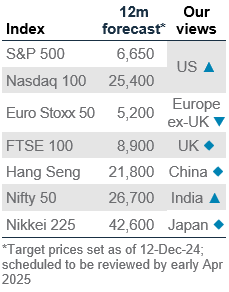
Fig. 13 US equities expected to lead global equities’ 2025 earnings growth; valuation of MSCI China back to the 10-year average after the recent strong rally
Consensus 2024 and 2025 earnings growth estimates for regional MSCI equity indices; Consensus 12m forward price-earnings ratio for MSCI China
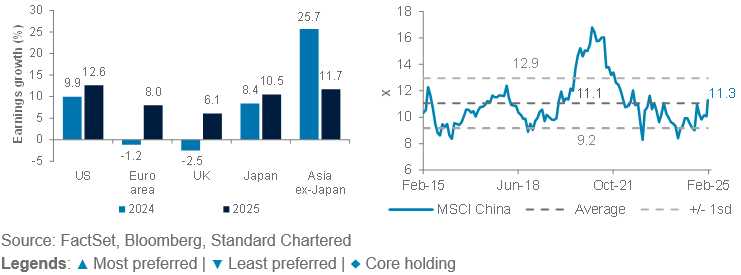
Extended optimism in the US
While the launch of China’s low-cost AI model, DeepSeek, and US President Trump’s tariff announcements weighed on market sentiment, we see a slew of factors supporting continued outperformance of US equities. US Q4 24 earnings were resilient, with EPS for the MSCI US index up by 9.9% in 2024. The US’ projected 2025 EPS growth of 12.6% and ROE of 20.8% are higher than other major equity markets. Potential policy surprises, including deregulation and private sector investment, are other factors supporting our ‘buy-on-dips’ stance in US equities.
Outside the US, lingering geopolitical tensions lead us to remain Neutral across other major markets, including Asia and the UK. We are Neutral Japan, as strengthening corporate governance
and intensification of domestic investments are offset by potential JPY appreciation, driven by continued monetary tightening from the Bank of Japan. Within Asia ex-Japan, we remain Overweight India equities on strong earnings growth in the large caps, and Indian government’s supportive budget, which cut individual income taxes to boost domestic consumption. We are Neutral China. After a strong rally in the past month, the 12-month forward P/E of MSCI China index is now trading around its historical average. However, trade uncertainty and structural concerns including deflation and property market headwinds remain. Lastly, we are Underweight South Korea equities as they are vulnerable to US tariff risks and global trade uncertainties.
Equity opportunistic views
|
Sharpening our US technology focus
- We have eight opportunistic equity buy ideas where we target positive absolute returns. This month, we close the broad US technology sector idea and rotate into the more specific US technology software sub-sector.
Changes to our buy Ideas
Closing US technology sector: We are closing for a 24.8% gain as we prefer to focus on the technology software sub-sector. Although we remain positive on the broad technology sector, we acknowledge potentially greater volatility with semiconductors, as future growth gets reassessed with the emergence of DeepSeek. Meanwhile, the hardware segment could face headwinds from retaliation against US tariffs.
Opening US technology software: We see software as a cleaner way to benefit from ongoing AI developments. DeepSeek is likely to lower the cost of AI tools, benefitting software providers who can integrate such tools into their product offerings. We also see less tariff headwinds with software. Weakness in corporate IT budgets is a risk.
Existing buy ideas
US communication services: Digital advertising, online entertainment and AI applications continue to drive robust growth. Valuation of the sector remains reasonable – at a discount to the broader market. Advertising softness is a risk.
US major banks: Banks have reported robust growth in capital markets, investment banking and fee income – which we expect to continue. Meanwhile, the deregulation tailwind remains. A sharp slowdown in the US economy is a risk.
US regional banks: The Republican government is expected to reduce the regulatory burden on smaller US banks. Fed rate cuts should also ease deposit pricing pressure for these banks. A sharp US slowdown is a risk.
US small-caps: Their large domestic exposure should benefit from US tariffs that limit international competition. US tax cuts and Fed rate cuts are tailwinds as small-caps tend to hold more floating rate debt. A US growth slowdown is a risk.
India large cap stocks: Indian equities have corrected by over 10% from their peak amid slowing growth, foreign investor selling and uncertainty over US tariffs. However, we see an improving risk-reward as the government budget and expected RBI policy easing are supportive of growth. Earnings growth for the next few years remain robust, while valuation has moved closer to the 10-year average and domestic inflows remain strong. Weaker-than-expected growth is a risk.
China non-financial high dividend SOEs: We continue to like the stability of high dividend state-owned enterprises
(SOEs). Non-financial SOEs are less exposed to the troubled property sector. Adverse regulatory changes are a risk.
Fig. 14 Opportunistic buy ideas
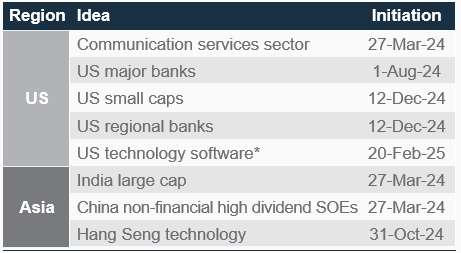
Source: Standard Chartered *New Idea
Sector views: technology supported by AI
We continue to like the US growth sectors of technology and communication, along with financials, which should benefit from deregulation. In Europe, we prefer a barbell approach, with a defensive exposure to communication and healthcare balanced by growth from technology. Undervalued financials remain attractive. In China, we prefer technology, communication and discretionary, which are tied to improving consumption and greater AI adoption.
Fig. 15 Our sector views by region
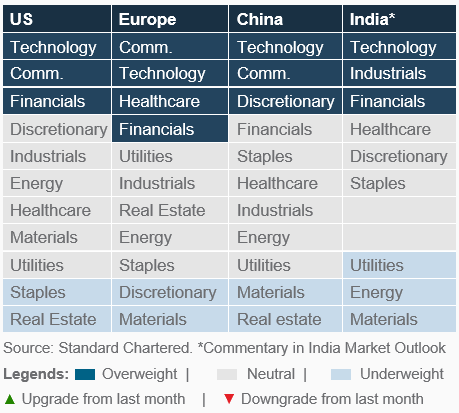
FX – at a glance
|
Key themes
We expect the USD to consolidate in a tight range around its 50-day moving average of 108 in the next 1-3 months. The sturdy US job market, persistent inflation and robust economic activity should keep the Fed from cutting rates in March, supporting the USD in the near term. However, prolonged trade tensions may hinder US economic growth, while ongoing uncertainty over tariffs is likely to weigh on the dollar, potentially leading to a softer USD on a 12-month horizon. EUR/USD is likely to trade around 1.02 on a 3-month horizon on a firmer greenback. Upside risk to the pair could arise from any fiscal stimulus after the German elections. GBP/USD is also likely to show resilience over the next 3 months underpinned by fiscal stability. The JPY has the most potential to strengthen further amid strong Japan wage growth and the BoJ’s continued rate hiking policy. CAD and CNH weakness are likely to extend amid softer commodity prices and uncertainty over China’s stimulus.
We largely retain forecasts for other currencies within a tight range. The CHF is likely to be rangebound over the next 1-3 months. The Swiss National Bank is expected to cut its key rate cut in March, but a fresh catalyst will likely be needed to push USD/CHF towards January highs. The AUD is expected to hold steady over the next 3 months, with a modestly bullish bias, amid the RBA’s cautious stance on rate cuts. However, the RBNZ is likely to continue cutting rates, although the pace of cuts is likely to slow to 25bps. Thus, we see the NZD upside risk capped at 0.57.
Key chart
The VXY index (benchmark for implied FX volatility in G7 currencies) is fluctuating around its 10-year average, suggesting moderate price swings in major FX pairs ahead. We expect currencies to be mostly rangebound in the next 1-3 months
Fig. 16 FX volatility is fluctuating around the 10-year average
Benchmark for implied FX volatility in G7 currencies; Table of forecasts
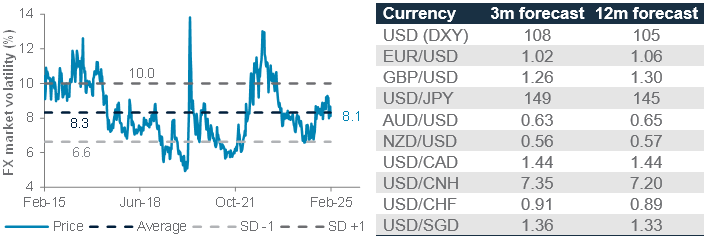
Source: Bloomberg, Standard Chartered
What is the near-term outlook for currencies?
Despite the choppy start to the year for the USD on trade uncertainty and the paring back of Fed rate cuts, implied FX volatility remains near its 10-year average. This indicates FX price swings are likely to be moderate, with the USD index likely stabilising at 108. We expect most currencies to move within a ±1% range over the next 1-3 months.
Mixed fundamentals are likely to enable the USD Index (DXY) to consolidate. US labour market and inflation remain resilient, while retail sales show signs of softening. Tariff news and Fed policy path are likely to be other key drivers. EUR/USD may face pressure and test the 1.02 support in the near term if the German election delivers a fragmented mandate. The UK economy is more resilient than expected, which should keep GBP/USD well supported around 1.26 as markets re-price BoE’s rate cut trajectory. Among G10 currencies, we see the
JPY as the main potential outperformer. Japan’s growth was stronger than expected in Q4 24 and wage growth accelerated, supporting the case for a more hawkish BoJ. We expect USD/JPY to test 149 in the next 1-3 months. We expect a less dovish SNB supporting a stable USD/CHF around the 50-day moving average of 0.91. Despite SNB governor noting the possibility of negative interest rates, Switzerland’s economy grew 0.4% in Q4 24, exceeding estimates. Meanwhile, SGD has gained against almost all major emerging Asia currencies so far this year. Further monetary policy loosening, following the MAS January easing decision, may push USD/SGD back to 1.36. We expect USD/CNH to edge towards 7.35 over the next 1-3 months, while China’s economy and inflation remain soft. China’s NPC meeting in March will be closely watched for any further fiscal stimulus policies.
Gold, crude oil – at a glance
|
|
||||
Key themes
We stay Overweight gold, raising our 3-month price target to USD 2,900/oz. Gold has had a strong start to the year, delivering a 12% YTD return and hitting a record USD 2,955 this week. US tariff uncertainty has fuelled this rally. With more details on reciprocal tariffs likely forthcoming, prices should remain well-supported. However, given stretched investor positioning, a brief correction towards USD 2,790 is possible, presenting a buying opportunity for long-term investors as structural drivers remain intact, in our view. Global central banks purchased over 1,000 tonnes of gold for the third consecutive year, while China increased its gold reserves for the third consecutive month in January. Additionally, a new pilot programme allowing some China insurers to allocate up to 1% of their assets to gold could drive further institutional demand.
We continue to expect the WTI crude oil price to stay in a range around USD 70/bbl over the next three months. Oil prices have pulled back from their brief rebound towards USD 80/bbl back into USD 67-72/bbl. In our view, fundamentals favour prices remaining in this range given (i) a strong supply pipeline, from both OPEC and non-OPEC sources, (ii) a more neutral level of investor positioning today and (iii) concerns about the pace of global growth (including the potential impact of tariffs on growth and energy demand). Reports of US-Russian talks aimed at ending the Ukraine war are likely to increase expectations of more global supply should these talks lead to reduced sanctions against Russia. Over the next 12 months, we believe prices could ease moderately further towards USD 65/bbl, based largely on our expectations that near-term drivers extend through the year and maintain a cap on oil prices.
Key chart
Gold has risen to record highs amid trade uncertainty, but a temporary pullback is likely. We would add on dips.
Oil, in contrast, has failed to hold on to gains, as expected. We expect prices to stay rangebound
Fig. 17 Trade uncertainty has driven gold prices to fresh record highs
LHS chart: Modelled gold prices with and without trade uncertainty as a factor
RHS chart: Crude-to-gold price ratio

Source: Bloomberg, Standard Chartered. As of 31 Jan 2025.*Gold prices modelled on US real yield, US dollar index (DXY), US CPI index, ETF holdings, geopolitical risk index, CFTC net positioning, Central bank net purchases, US Trade Uncertainty index. Gold model is meant to illustrate relationships with key variables and is not intended for forecasting purposes.
Tariff fears drive exchange-for-physical surge
Fears of potential US tariffs have created distortions in the gold market. The exchange-for-physical (EFP) spread – which track price differences between New York Comex futures and London spot prices – has surged in recent weeks to as high as USD 60 according to some estimates. Typically, when Comex futures trade substantially above London spot prices, traders buy physical gold in London and ship them to New York to capture arbitrage profits. This keeps both prices largely in sync. But concerns over potential US tariffs on gold imports, which would make shipping gold to New York more expensive and the
arbitrage trade unviable, have resulted in a widening of the EFP and a tightening of physical gold supply in London. As a result, gold lease rates – the return that bullion holders earn from loaning out their gold – has also surged.
While there are examples of gold being subjected to tariffs, these have largely been done for monetary policy or economic stability reasons. For instance, India has imposed gold import duties to manage its current account deficit and reduce gold consumption. We do not expect US import tariffs to ultimately include gold, but ongoing tariff uncertainty should sustain the price gap between futures and spot prices, keeping gold prices well-supported.
Additional perspectives
Quant perspective
Maximally bullish equities, but higher short-term volatility
|
|
||||
Summary
Our stock-bond model is currently heavily Overweight (OW) equities. This is driven by (i) a halt in the deterioration in earnings upgrades-to-downgrades ratio for global stocks (on a 3-month rolling change basis) after declines since August 2024 and (ii) a recovery in our market breadth signal, which shows over 60% of equity markets now sit above their respective 200-day moving average. With the MSCI World Index reaching a new high after rebounding strongly from the selloff in AI stocks in January, our model’s YTD outperformance compared to the 60-40 equity-bond benchmark has also risen to 1.0%. This extends our model’s strong track record, which shows a 37% gain (or 6.8% outperformance) since its inception in February 2023.
Our technical models are bullish US, UK and China. Our modelson S&P500supported buying the dip during the AI stock selloff in January. The index has since rebounded and the signals from our model remains bullish because (i) the long term trend remains strong, (ii) the rise in recent market volatility is relatively tame and (iii) our market regime indicator retains a bullish bias. The models also prefer to participate in the rebound of European equities via the UK due to more attractive risk/reward. Finally, our short-term models have also turned bullish on China equities as our market regime indicator turned bullish. The models are currently Neutral on Asian equities more broadly due to their muted price action compared with the preferred markets.
Our market diversity indicators flag stretched positioning in European financial and communication services sectors. Both the sectors have rallied strongly, with more than 12% gains YTD. Our market diversity indicator suggests higher risks of a short-term consolidation or reversal. This also indirectly implies a slower pace of gains in the MSCI Europe Index.
Key chart
Our stock-bond model is heavily OW equities as our model score rose to the maximum 5 in January, from 2 in December, driven by improvement in the earnings outlook and the market breadth factor
Fig. 18 Breakdown of our stock-bond rotation model’s scores since inception in Feb-23
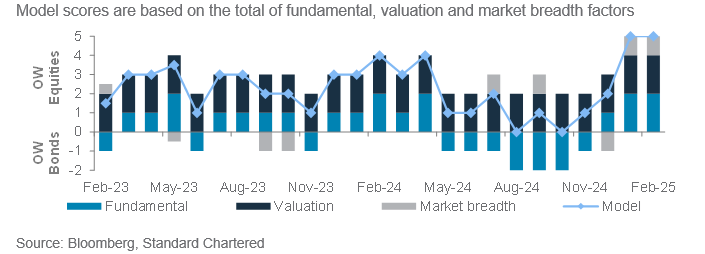
Historically, the S&P500 index has generated positive returns under the model’s rangebound regime, but this comes with higher market risks
Fig. 19 Our technical model for the S&P500 index is in a bullish bias mode

Fig. 20 Long- and short-term quantitative models are bullish risky assets
Long-term models below have a typical time horizon of 3–6 months, while short-term models have a 1–3 month horizon
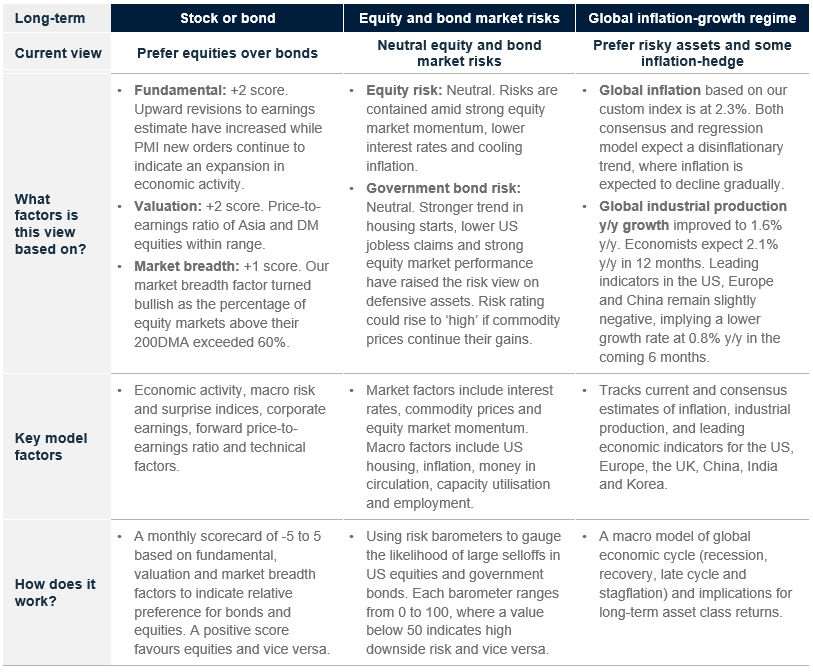
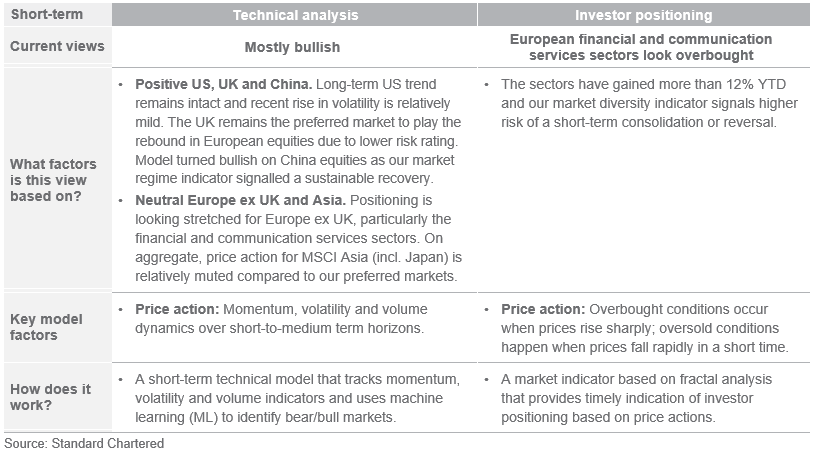
Performance review
Foundation: Asset allocation summary
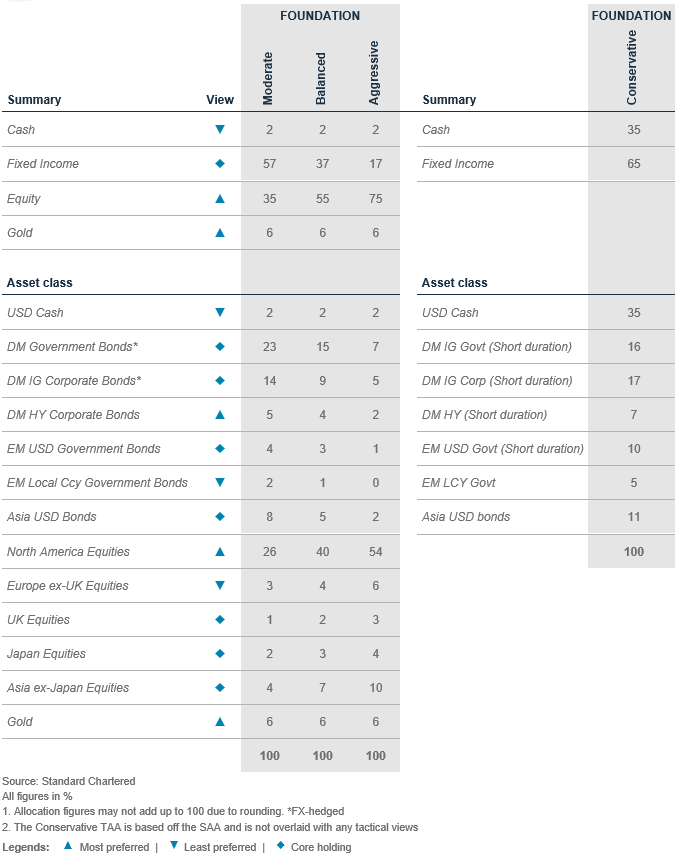
Foundation+: Asset allocation summary
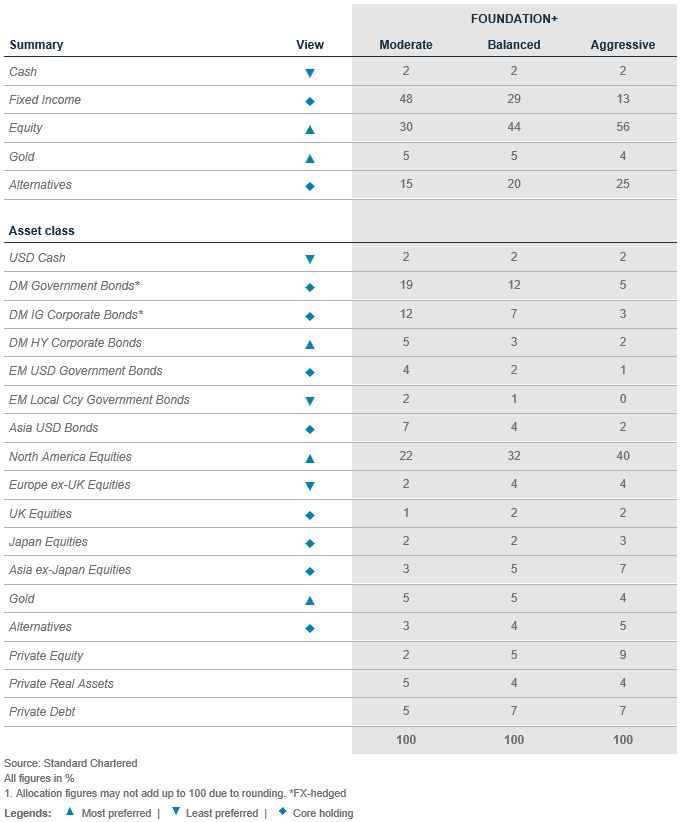
Market performance summary
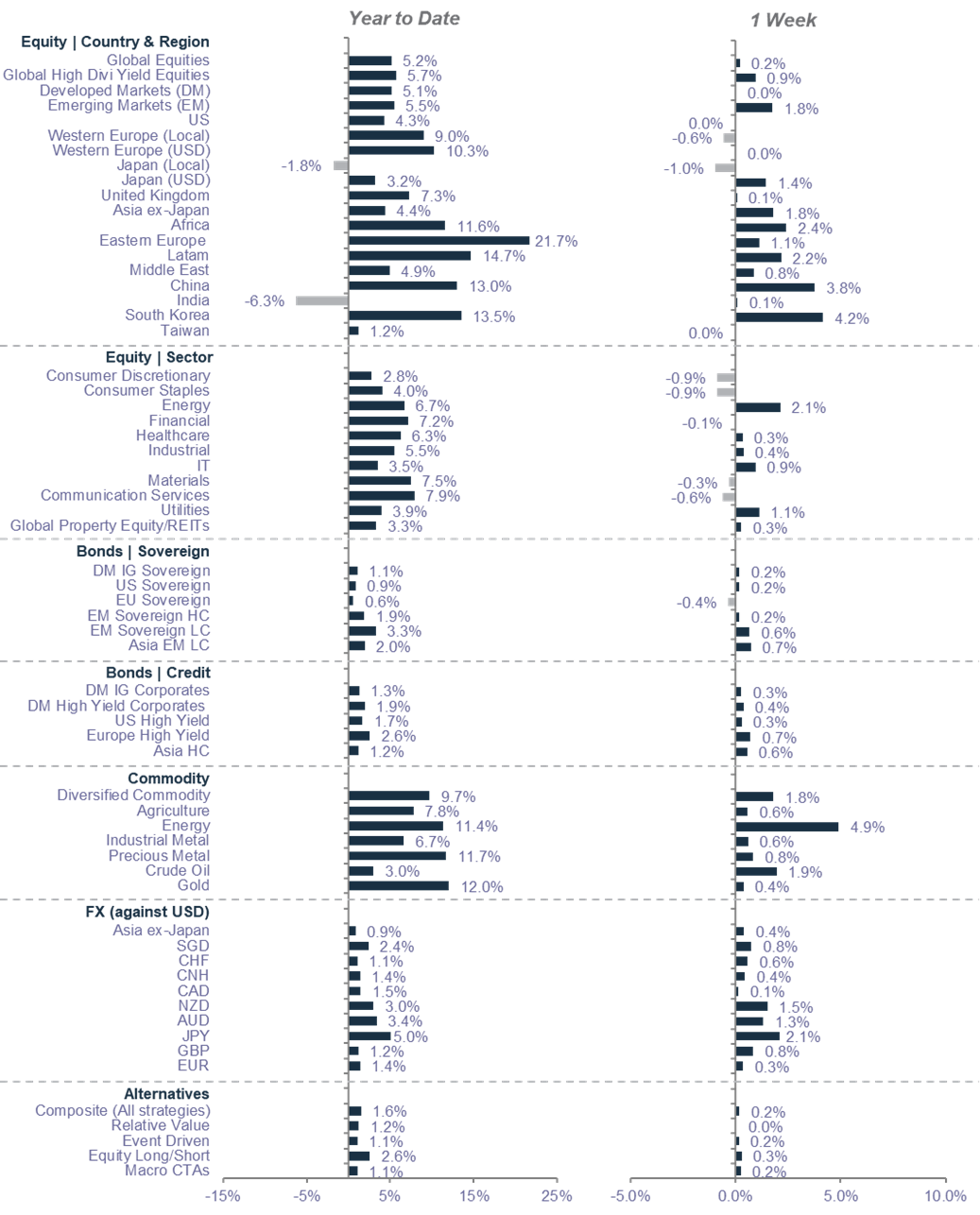
Source: MSCI, JPMorgan, Citigroup, Dow Jones, HFRX, FTSE, Bloomberg, Standard Chartered
*All performance shown in USD terms, unless otherwise stated
*YTD performance data from 31 December 2023 to 20 February 2025; 1-week performance from 13 to 20 February 2025
Our key forecasts and calendar events

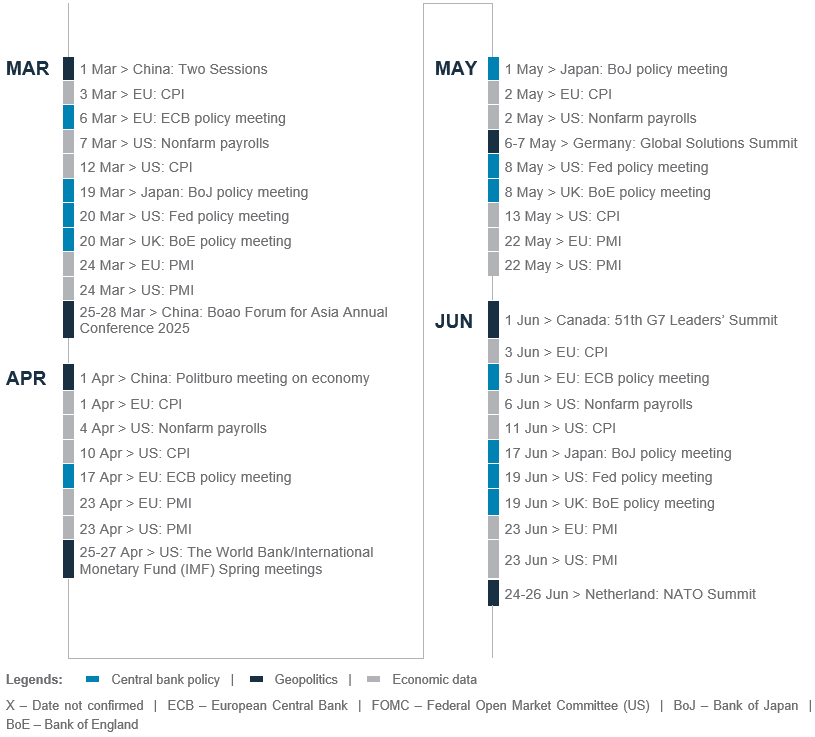
Today, Tomorrow and Forever

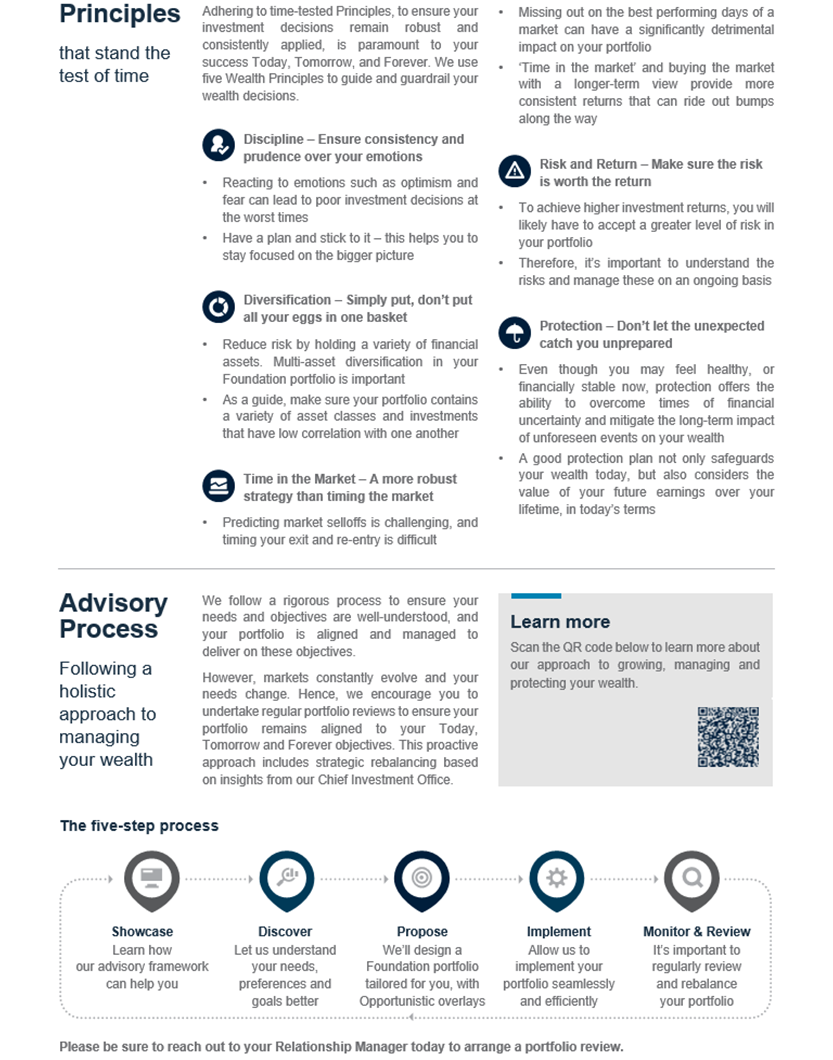

Explanatory notes
1. The figures on page 5 show allocations for a moderately aggressive risk profile only – different risk profiles may produce significantly different asset allocation results. Page 5 is only an example, provided for general information only and they do not constitute investment advice, an offer, recommendation or solicitation. They do not take into account the specific investment objectives, needs or risk tolerances of a particular person or class of persons and they have not been prepared for any particular person or class of persons.
2. Contingent Convertibles are complex financial instruments and are not a suitable or appropriate investment for all investors. This document is not an offer to sell or an invitation to buy any securities or any beneficial interests therein. Contingent convertible securities are not intended to be sold and should not be sold to retail clients in the European Economic Area (EEA) (each as defined in the Policy Statement on the Restrictions on the Retail Distribution of Regulatory Capital Instruments (Feedback to CP14/23 and Final Rules) (“Policy Statement”), read together with the Product Intervention (Contingent Convertible Instruments and Mutual Society Shares) Instrument 2015 (“Instrument”, and together with the Policy Statement, the “Permanent Marketing Restrictions”), which were published by the United Kingdom’s Financial Conduct Authority in June 2015), other than in circumstances that do not give rise to a contravention of the Permanent Marketing Restrictions.
Disclosure
This document is confidential and may also be privileged. If you are not the intended recipient, please destroy all copies and notify the sender immediately. This document is being distributed for general information only and is subject to the relevant disclaimers available at our Standard Chartered website under Regulatory disclosures. It is not and does not constitute research material, independent research, an offer, recommendation or solicitation to enter into any transaction or adopt any hedging, trading or investment strategy, in relation to any securities or other financial instruments. This document is for general evaluation only. It does not take into account the specific investment objectives, financial situation or particular needs of any particular person or class of persons and it has not been prepared for any particular person or class of persons. You should not rely on any contents of this document in making any investment decisions. Before making any investment, you should carefully read the relevant offering documents and seek independent legal, tax and regulatory advice. In particular, we recommend you to seek advice regarding the suitability of the investment product, taking into account your specific investment objectives, financial situation or particular needs, before you make a commitment to purchase the investment product. Opinions, projections and estimates are solely those of SC at the date of this document and subject to change without notice. Past performance is not indicative of future results and no representation or warranty is made regarding future performance. The value of investments, and the income from them, can go down as well as up, and you may not recover the amount of your original investment. You are not certain to make a profit and may lose money. Any forecast contained herein as to likely future movements in rates or prices or likely future events or occurrences constitutes an opinion only and is not indicative of actual future movements in rates or prices or actual future events or occurrences (as the case may be). This document must not be forwarded or otherwise made available to any other person without the express written consent of the Standard Chartered Group (as defined below). Standard Chartered Bank is incorporated in England with limited liability by Royal Charter 1853 Reference Number ZC18. The Principal Office of the Company is situated in England at 1 Basinghall Avenue, London, EC2V 5DD. Standard Chartered Bank is authorised by the Prudential Regulation Authority and regulated by the Financial Conduct Authority and Prudential Regulation Authority. Standard Chartered PLC, the ultimate parent company of Standard Chartered Bank, together with its subsidiaries and affiliates (including each branch or representative office), form the Standard Chartered Group. Standard Chartered Private Bank is the private banking division of Standard Chartered. Private banking activities may be carried out internationally by different legal entities and affiliates within the Standard Chartered Group (each an “SC Group Entity”) according to local regulatory requirements. Not all products and services are provided by all branches, subsidiaries and affiliates within the Standard Chartered Group. Some of the SC Group Entities only act as representatives of Standard Chartered Private Bank and may not be able to offer products and services or offer advice to clients.
Copyright © 2025, Accounting Research & Analytics, LLC d/b/a CFRA (and its affiliates, as applicable). Reproduction of content provided by CFRA in any form is prohibited except with the prior written permission of CFRA. CFRA content is not investment advice and a reference to or observation concerning a security or investment provided in the CFRA SERVICES is not a recommendation to buy, sell or hold such investment or security or make any other investment decisions. The CFRA content contains opinions of CFRA based upon publicly-available information that CFRA believes to be reliable and the opinions are subject to change without notice. This analysis has not been submitted to, nor received approval from, the United States Securities and Exchange Commission or any other regulatory body. While CFRA exercised due care in compiling this analysis, CFRA, ITS THIRD-PARTY SUPPLIERS, AND ALL RELATED ENTITIES SPECIFICALLY DISCLAIM ALL WARRANTIES, EXPRESS OR IMPLIED, INCLUDING, BUT NOT LIMITED TO, ANY WARRANTIES OF MERCHANTABILITY OR FITNESS FOR A PARTICULAR PURPOSE OR USE, to the full extent permitted by law, regarding the accuracy, completeness, or usefulness of this information and assumes no liability with respect to the consequences of relying on this information for investment or other purposes. No content provided by CFRA (including ratings, credit-related analyses and data, valuations, model, software or other application or output therefrom) or any part thereof may be modified, reverse engineered, reproduced or distributed in any form by any means, or stored in a database or retrieval system, without the prior written permission of CFRA, and such content shall not be used for any unlawful or unauthorized purposes. CFRA and any third-party providers, as well as their directors, officers, shareholders, employees or agents do not guarantee the accuracy, completeness, timeliness or availability of such content. In no event shall CFRA, its affiliates, or their third-party suppliers be liable for any direct, indirect, special, or consequential damages, costs, expenses, legal fees, or losses (including lost income or lost profit and opportunity costs) in connection with a subscriber’s, subscriber’s customer’s, or other’s use of CFRA’s content.
Market Abuse Regulation (MAR) Disclaimer
Banking activities may be carried out internationally by different branches, subsidiaries and affiliates within the Standard Chartered Group according to local regulatory requirements. Opinions may contain outright “buy”, “sell”, “hold” or other opinions. The time horizon of this opinion is dependent on prevailing market conditions and there is no planned frequency for updates to the opinion. This opinion is not independent of Standard Chartered Group’s trading strategies or positions. Standard Chartered Group and/or its affiliates or its respective officers, directors, employee benefit programmes or employees, including persons involved in the preparation or issuance of this document may at any time, to the extent permitted by applicable law and/or regulation, be long or short any securities or financial instruments referred to in this document or have material interest in any such securities or related investments. Therefore, it is possible, and you should assume, that Standard Chartered Group has a material interest in one or more of the financial instruments mentioned herein. Please refer to our Standard Chartered website under Regulatory disclosures for more detailed disclosures, including past opinions/ recommendations in the last 12 months and conflict of interests, as well as disclaimers. A covering strategist may have a financial interest in the debt or equity securities of this company/issuer. This document must not be forwarded or otherwise made available to any other person without the express written consent of Standard Chartered Group.
Sustainable Investments
Any ESG data used or referred to has been provided by Morningstar, Sustainalytics, MSCI or Bloomberg. Refer to 1) Morningstar website under Sustainable Investing, 2) Sustainalytics website under ESG Risk Ratings, 3) MCSI website under ESG Business Involvement Screening Research and 4) Bloomberg green, social & sustainability bonds guide for more information. The ESG data is as at the date of publication based on data provided, is for informational purpose only and is not warranted to be complete, timely, accurate or suitable for a particular purpose, and it may be subject to change. Sustainable Investments (SI): This refers to funds that have been classified as ‘Sustainable Investments’ by Morningstar. SI funds have explicitly stated in their prospectus and regulatory filings that they either incorporate ESG factors into the investment process or have a thematic focus on the environment, gender diversity, low carbon, renewable energy, water or community development. For equity, it refers to shares/stocks issued by companies with Sustainalytics ESG Risk Rating of Low/Negligible. For bonds, it refers to debt instruments issued by issuers with Sustainalytics ESG Risk Rating of Low/Negligible, and/or those being certified green, social, sustainable bonds by Bloomberg. For structured products, it refers to products that are issued by any issuer who has a Sustainable Finance framework that aligns with Standard Chartered’s Green and Sustainable Product Framework, with underlying assets that are part of the Sustainable Investment universe or separately approved by Standard Chartered’s Sustainable Finance Governance Committee. Sustainalytics ESG risk ratings shown are factual and are not an indicator that the product is classified or marketed as “green”, “sustainable” or similar under any particular classification system or framework.
Country/Market Specific Disclosures
Botswana: This document is being distributed in Botswana by, and is attributable to, Standard Chartered Bank Botswana Limited which is a financial institution licensed under the Section 6 of the Banking Act CAP 46.04 and is listed in the Botswana Stock Exchange. Brunei Darussalam: This document is being distributed in Brunei Darussalam by, and is attributable to, Standard Chartered Bank (Brunei Branch) | Registration Number RFC/61 and Standard Chartered Securities (B) Sdn Bhd | Registration Number RC20001003. Standard Chartered Bank is incorporated in England with limited liability by Royal Charter 1853 Reference Number ZC18. Standard Chartered Securities (B) Sdn Bhd is a limited liability company registered with the Registry of Companies with Registration Number RC20001003 and licensed by Brunei Darussalam Central Bank as a Capital Markets Service License Holder with License Number BDCB/R/CMU/S3-CL and it is authorised to conduct Islamic investment business through an Islamic window. China Mainland: This document is being distributed in China by, and is attributable to, Standard Chartered Bank (China) Limited which is mainly regulated by National Financial Regulatory Administration (NFRA), State Administration of Foreign Exchange (SAFE), and People’s Bank of China (PBOC). Hong Kong: In Hong Kong, this document, except for any portion advising on or facilitating any decision on futures contracts trading, is distributed by Standard Chartered Bank (Hong Kong) Limited (“SCBHK”), a subsidiary of Standard Chartered PLC. SCBHK has its registered address at 32/F, Standard Chartered Bank Building, 4-4A Des Voeux Road Central, Hong Kong and is regulated by the Hong Kong Monetary Authority and registered with the Securities and Futures Commission (“SFC”) to carry on Type 1 (dealing in securities), Type 4 (advising on securities), Type 6 (advising on corporate finance) and Type 9 (asset management) regulated activity under the Securities and Futures Ordinance (Cap. 571) (“SFO”) (CE No. AJI614). The contents of this document have not been reviewed by any regulatory authority in Hong Kong and you are advised to exercise caution in relation to any offer set out herein. If you are in doubt about any of the contents of this document, you should obtain independent professional advice. Any product named herein may not be offered or sold in Hong Kong by means of any document at any time other than to “professional investors” as defined in the SFO and any rules made under that ordinance. In addition, this document may not be issued or possessed for the purposes of issue, whether in Hong Kong or elsewhere, and any interests may not be disposed of, to any person unless such person is outside Hong Kong or is a “professional investor” as defined in the SFO and any rules made under that ordinance, or as otherwise may be permitted by that ordinance. In Hong Kong, Standard Chartered Private Bank is the private banking division of SCBHK, a subsidiary of Standard Chartered PLC. Ghana: Standard Chartered Bank Ghana Limited accepts no liability and will not be liable for any loss or damage arising directly or indirectly (including special, incidental or consequential loss or damage) from your use of these documents. Past performance is not indicative of future results and no representation or warranty is made regarding future performance. You should seek advice from a financial adviser on the suitability of an investment for you, taking into account these factors before making a commitment to invest in an investment. To unsubscribe from receiving further updates, please send an email to feedback.ghana@sc.com. Please do not reply to this email. Call our Priority Banking on 0302610750 for any questions or service queries. You are advised not to send any confidential and/or important information to Standard Chartered via e-mail, as Standard Chartered makes no representations or warranties as to the security or accuracy of any information transmitted via e-mail. Standard Chartered shall not be responsible for any loss or damage suffered by you arising from your decision to use e-mail to communicate with the Bank. India: This document is being distributed in India by Standard Chartered in its capacity as a distributor of mutual funds and referrer of any other third party financial products. Standard Chartered does not offer any ‘Investment Advice’ as defined in the Securities and Exchange Board of India (Investment Advisers) Regulations, 2013 or otherwise. Services/products related securities business offered by Standard Charted are not intended for any person, who is a resident of any jurisdiction, the laws of which imposes prohibition on soliciting the securities business in that jurisdiction without going through the registration requirements and/or prohibit the use of any information contained in this document. Indonesia: This document is being distributed in Indonesia by Standard Chartered Bank, Indonesia branch, which is a financial institution licensed, registered and supervised by Otoritas Jasa Keuangan (Financial Service Authority). Jersey: In Jersey, Standard Chartered Private Bank is the Registered Business Name of the Jersey Branch of Standard Chartered Bank. The Jersey Branch of Standard Chartered Bank is regulated by the Jersey Financial Services Commission. Copies of the latest audited accounts of Standard Chartered Bank are available from its principal place of business in Jersey: PO Box 80, 15 Castle Street, St Helier, Jersey JE4 8PT. Standard Chartered Bank is incorporated in England with limited liability by Royal Charter in 1853 Reference Number ZC 18. The Principal Office of the Company is situated in England at 1 Basinghall Avenue, London, EC2V 5DD. Standard Chartered Bank is authorised by the Prudential Regulation Authority and regulated by the Financial Conduct Authority and Prudential Regulation Authority. The Jersey Branch of Standard Chartered Bank is also an authorised financial services provider under license number 44946 issued by the Financial Sector Conduct Authority of the Republic of South Africa. Jersey is not part of the United Kingdom and all business transacted with Standard Chartered Bank, Jersey Branch and other SC Group Entity outside of the United Kingdom, are not subject to some or any of the investor protection and compensation schemes available under United Kingdom law. Kenya: This document is being distributed in Kenya by and is attributable to Standard Chartered Bank Kenya Limited. Investment Products and Services are distributed by Standard Chartered Investment Services Limited, a wholly owned subsidiary of Standard Chartered Bank Kenya Limited that is licensed by the Capital Markets Authority in Kenya, as a Fund Manager. Standard Chartered Bank Kenya Limited is regulated by the Central Bank of Kenya. Malaysia: This document is being distributed in Malaysia by Standard Chartered Bank Malaysia Berhad (“SCBMB”). Recipients in Malaysia should contact SCBMB in relation to any matters arising from, or in connection with, this document. This document has not been reviewed by the Securities Commission Malaysia. The product lodgement, registration, submission or approval by the Securities Commission of Malaysia does not amount to nor indicate recommendation or endorsement of the product, service or promotional activity. Investment products are not deposits and are not obligations of, not guaranteed by, and not protected by SCBMB or any of the affiliates or subsidiaries, or by Perbadanan Insurans Deposit Malaysia, any government or insurance agency. Investment products are subject to investment risks, including the possible loss of the principal amount invested. SCBMB expressly disclaim any liability and responsibility for any loss arising directly or indirectly (including special, incidental or consequential loss or damage) arising from the financial losses of the Investment Products due to market condition. Nigeria: This document is being distributed in Nigeria by Standard Chartered Bank Nigeria Limited (SCB Nigeria), a bank duly licensed and regulated by the Central Bank of Nigeria. SCB Nigeria accepts no liability for any loss or damage arising directly or indirectly (including special, incidental or consequential loss or damage) from your use of these documents. You should seek advice from a financial adviser on the suitability of an investment for you, taking into account these factors before making a commitment to invest in an investment. To unsubscribe from receiving further updates, please send an email to clientcare.ng@sc.com requesting to be removed from our mailing list. Please do not reply to this email. Call our Priority Banking on 02 012772514 for any questions or service queries. Standard Chartered shall not be responsible for any loss or damage arising from your decision to send confidential and/or important information to Standard Chartered via e-mail, as Standard Chartered makes no representations or warranties as to the security or accuracy of any information transmitted via e-mail. Pakistan: This document is being distributed in Pakistan by, and attributable to Standard Chartered Bank (Pakistan) Limited having its registered office at PO Box 5556, I.I Chundrigar Road Karachi, which is a banking company registered with State Bank of Pakistan under Banking Companies Ordinance 1962 and is also having licensed issued by Securities & Exchange Commission of Pakistan for Security Advisors. Standard Chartered Bank (Pakistan) Limited acts as a distributor of mutual funds and referrer of other third-party financial products. Singapore: This document is being distributed in Singapore by, and is attributable to, Standard Chartered Bank (Singapore) Limited (Registration No. 201224747C/ GST Group Registration No. MR-8500053-0, “SCBSL”). Recipients in Singapore should contact SCBSL in relation to any matters arising from, or in connection with, this document. SCBSL is an indirect wholly owned subsidiary of Standard Chartered Bank and is licensed to conduct banking business in Singapore under the Singapore Banking Act, 1970. Standard Chartered Private Bank is the private banking division of SCBSL. IN RELATION TO ANY SECURITY OR SECURITIES-BASED DERIVATIVES CONTRACT REFERRED TO IN THIS DOCUMENT, THIS DOCUMENT, TOGETHER WITH THE ISSUER DOCUMENTATION, SHALL BE DEEMED AN INFORMATION MEMORANDUM (AS DEFINED IN SECTION 275 OF THE SECURITIES AND FUTURES ACT, 2001 (“SFA”)). THIS DOCUMENT IS INTENDED FOR DISTRIBUTION TO ACCREDITED INVESTORS, AS DEFINED IN SECTION 4A(1)(a) OF THE SFA, OR ON THE BASIS THAT THE SECURITY OR SECURITIES-BASED DERIVATIVES CONTRACT MAY ONLY BE ACQUIRED AT A CONSIDERATION OF NOT LESS THAN S$200,000 (OR ITS EQUIVALENT IN A FOREIGN CURRENCY) FOR EACH TRANSACTION. Further, in relation to any security or securities-based derivatives contract, neither this document nor the Issuer Documentation has been registered as a prospectus with the Monetary Authority of Singapore under the SFA. Accordingly, this document and any other document or material in connection with the offer or sale, or invitation for subscription or purchase, of the product may not be circulated or distributed, nor may the product be offered or sold, or be made the subject of an invitation for subscription or purchase, whether directly or indirectly, to persons other than a relevant person pursuant to section 275(1) of the SFA, or any person pursuant to section 275(1A) of the SFA, and in accordance with the conditions specified in section 275 of the SFA, or pursuant to, and in accordance with the conditions of, any other applicable provision of the SFA. In relation to any collective investment schemes referred to in this document, this document is for general information purposes only and is not an offering document or prospectus (as defined in the SFA). This document is not, nor is it intended to be (i) an offer or solicitation of an offer to buy or sell any capital markets product; or (ii) an advertisement of an offer or intended offer of any capital markets product. Deposit Insurance Scheme: Singapore dollar deposits of non-bank depositors are insured by the Singapore Deposit Insurance Corporation, for up to S$100,000 in aggregate per depositor per Scheme member by law. Foreign currency deposits, dual currency investments, structured deposits and other investment products are not insured. This advertisement has not been reviewed by the Monetary Authority of Singapore. Taiwan: SC Group Entity or Standard Chartered Bank (Taiwan) Limited (“SCB (Taiwan)”) may be involved in the financial instruments contained herein or other related financial instruments. The author of this document may have discussed the information contained herein with other employees or agents of SC or SCB (Taiwan). The author and the above-mentioned employees of SC or SCB (Taiwan) may have taken related actions in respect of the information involved (including communication with customers of SC or SCB (Taiwan) as to the information contained herein). The opinions contained in this document may change, or differ from the opinions of employees of SC or SCB (Taiwan). SC and SCB (Taiwan) will not provide any notice of any changes to or differences between the above-mentioned opinions. This document may cover companies with which SC or SCB (Taiwan) seeks to do business at times and issuers of financial instruments. Therefore, investors should understand that the information contained herein may serve as specific purposes as a result of conflict of interests of SC or SCB (Taiwan). SC, SCB (Taiwan), the employees (including those who have discussions with the author) or customers of SC or SCB (Taiwan) may have an interest in the products, related financial instruments or related derivative financial products contained herein; invest in those products at various prices and on different market conditions; have different or conflicting interests in those products. The potential impacts include market makers’ related activities, such as dealing, investment, acting as agents, or performing financial or consulting services in relation to any of the products referred to in this document. UAE: DIFC – Standard Chartered Bank is incorporated in England with limited liability by Royal Charter 1853 Reference Number ZC18.The Principal Office of the Company is situated in England at 1 Basinghall Avenue, London, EC2V 5DD. Standard Chartered Bank is authorised by the Prudential Regulation Authority and regulated by the Financial Conduct Authority and Prudential Regulation Authority. Standard Chartered Bank, Dubai International Financial Centre having its offices at Dubai International Financial Centre, Building 1, Gate Precinct, P.O. Box 999, Dubai, UAE is a branch of Standard Chartered Bank and is regulated by the Dubai Financial Services Authority (“DFSA”). This document is intended for use only by Professional Clients and is not directed at Retail Clients as defined by the DFSA Rulebook. In the DIFC we are authorised to provide financial services only to clients who qualify as Professional Clients and Market Counterparties and not to Retail Clients. As a Professional Client you will not be given the higher retail client protection and compensation rights and if you use your right to be classified as a Retail Client we will be unable to provide financial services and products to you as we do not hold the required license to undertake such activities. For Islamic transactions, we are acting under the supervision of our Shariah Supervisory Committee. Relevant information on our Shariah Supervisory Committee is currently available on the Standard Chartered Bank website in the Islamic banking section. For residents of the UAE – Standard Chartered Bank UAE does not provide financial analysis or consultation services in or into the UAE within the meaning of UAE Securities and Commodities Authority Decision No. 48/r of 2008 concerning financial consultation and financial analysis. Uganda: Our Investment products and services are distributed by Standard Chartered Bank Uganda Limited, which is licensed by the Capital Markets Authority as an investment adviser. United Kingdom: In the UK, Standard Chartered Bank is authorised by the Prudential Regulation Authority and regulated by the Financial Conduct Authority and Prudential Regulation Authority. This communication has been approved by Standard Chartered Bank for the purposes of Section 21 (2) (b) of the United Kingdom’s Financial Services and Markets Act 2000 (“FSMA”) as amended in 2010 and 2012 only. Standard Chartered Bank (trading as Standard Chartered Private Bank) is also an authorised financial services provider (license number 45747) in terms of the South African Financial Advisory and Intermediary Services Act, 2002. The Materials have not been prepared in accordance with UK legal requirements designed to promote the independence of investment research, and that it is not subject to any prohibition on dealing ahead of the dissemination of investment research. Vietnam: This document is being distributed in Vietnam by, and is attributable to, Standard Chartered Bank (Vietnam) Limited which is mainly regulated by State Bank of Vietnam (SBV). Recipients in Vietnam should contact Standard Chartered Bank (Vietnam) Limited for any queries regarding any content of this document. Zambia: This document is distributed by Standard Chartered Bank Zambia Plc, a company incorporated in Zambia and registered as a commercial bank and licensed by the Bank of Zambia under the Banking and Financial Services Act Chapter 387 of the Laws of Zambia.
